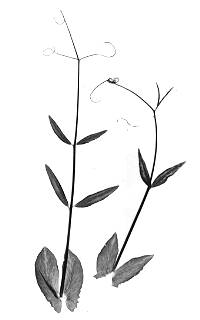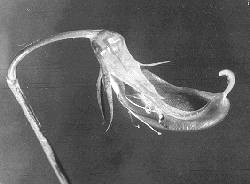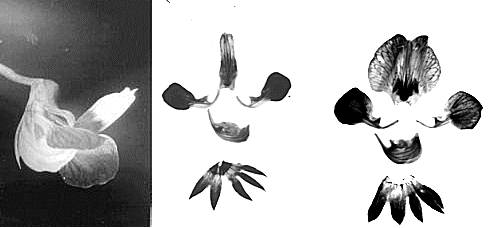

A lathyroides-phenotype mutation affecting both foliage and flower structures
Berdnikov, V.A., Gorel, F.L.
Institute of Cytology
and Genetics
Kosterin, O.E. and Rozov,
S.M. Novosibirsk
630090, Russia
A recessive mutant with substantially altered leaflets (Fig. 1) and petals (Fig. 2) was detected among M2 plants following treatment of the line SG with 0.15% EMS. We called the mutant narrow standard because the most striking effect of the mutation is on the standard petal, which is reduced to a narrow strip (Fig. 2). In addition, the mutation reduces the width of the leaflets to one third to one quarter of normal and the width of the stipules is reduced to a lesser extent (Fig. 1). The tendrils are also flattened and somewhat resemble those of heterozygous Tl/tl-w plants. They acquire a very narrow rudiment of leaf plate along their sides almost disappearing at the apex, but even in their apical parts the tendrils differ from normal by having a distinct dorsal groove. Apart from the striking effect on the standard petal, other structures of the flower appear to be unaffected, but after fertilization the carpel develops into an abnormal reduced pod without seeds and with the dorsal suture opened (Fig. 3). In spite of female sterility, the mutant plants are vigorous and their proportion among F2 populations was very close to one quarter. The pollen is viable and can readily be used for pollination.
We could not find linkage between the new mutation and markers a, i, r, tl, gp, cri, le and n involved in three crosses. The cross-over values did not deviate significantly from 50%.
The phenotype of the narrow standard mutant resembles in many respects that described by Nilsson-Leissner (4) and Blixt et al. (1) under the name aphacoides. Lamprecht (3) subsequently changed the name to lathyroides with the gene symbol lath. As described by Lamprecht (2), the flowers, including carpel, of the lath mutant resemble those of our mutant except that in the case of lath the androecium was also severely distorted, with anthers missing from part of the filaments and normal pollen could be found in a few anthers only. In addition, in the apical part of the lath shoots the flowers became less anomalous. The corolla became nearly normal although the gynoecium remained open and malformed with the ovules outside the ovary. In the narrow standard mutant, the flower structure is stable throughout the shoot. Unfortunately, we had no lath line available to test for allelism. That is a matter for further study. However, we suppose there is a strong possibility that our mutant is allelic with lath. The new mutation has the advantage of being easily maintained in a heterozygous state, by pollination of normal plants with pollen of their mutant siblings, and so can be useful for understanding the control of leaf and flower development. In addition, it can be used, in combination with male sterility factors, for constructing cross-pollinating populations of pea.
Acknowledgements. We thank Prof. I.C. Murfet for providing important literature information. This work was partly supported by the Russian State Fund for Fundamental Research.
____________


Fig. 1. Leaves of the narrow standard mutant. Fig. 3. An abortive pod of the narrow standard mutant.

Fig. 2. Flowers of the narrow standard mutant (left and middle) and a normal flower (right).